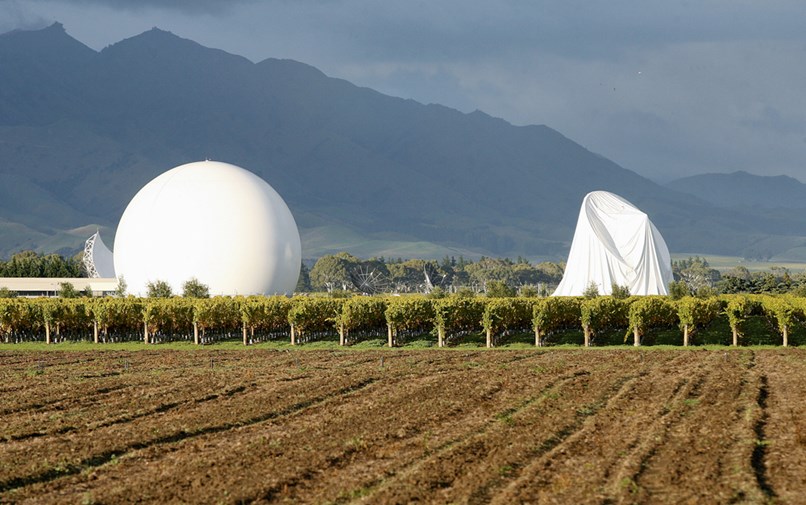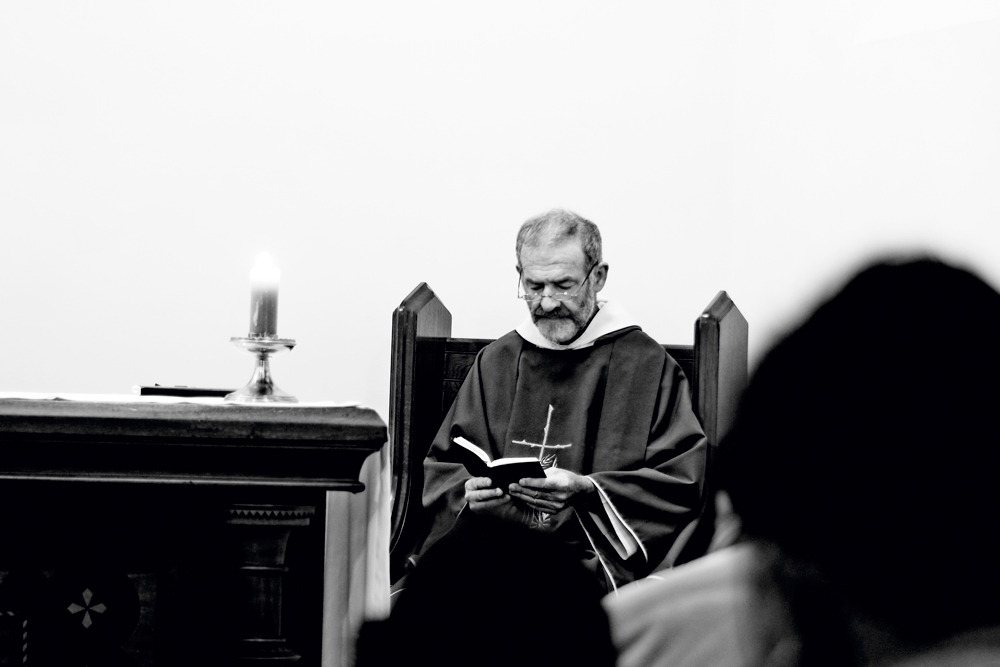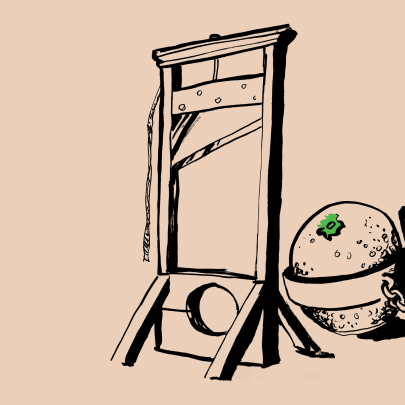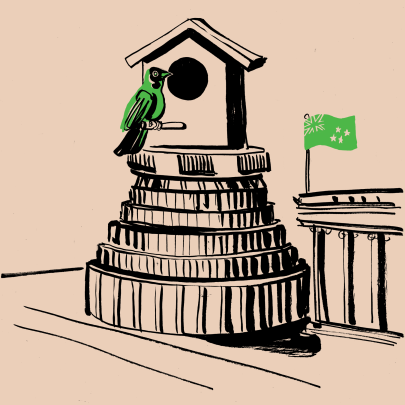Sep 15, 2014 Politics

Why did the government, so intent on prosecution, quietly drop its civil case for damages against the spy-dome-busting Waihopai Three? Genevieve O’Halloran asks if the potential for election-year embarrassment was at the heart of the Crown’s withdrawal.
First published in North & South, April 2014.
The media dubbed them the Waihopai Three, a name that suggests a sinister sort of terrorist glamour, with its echoes of John le Carré and the Guildford Four. The name was at odds with the trio who stood in the Blenheim District Court, charged with criminal damage and burglary. Sam Land, looking even younger than 24, could have just ducked out of early morning milking; Leason, with his impressive beard and checked shirt, looked like he was at a casting call for The Hobbit; and Murnane was pensive, composed, Gandalf-esque.
I knew Father Murnane already. I’d been in his congregation, dragged along to Mass every Sunday by my stoically Catholic parents. He was a gentle, quietly humorous man. The Mass he presided over was a progressive sort of affair, run in the basement of an inner-city Auckland church, and attended by alternative types and local homeless people. (This was the early 90s, when derelict houses in Grey Lynn were inhabited by Auckland’s poor, not snapped up by property developers for millions.)
The service was run largely by women in kaftans and greenstone earrings, and prayers were addressed to a gender-neutral creator, rather than a patriarchal deity. The priest was allowed to carry out bits of the Mass the kaftan-wearers couldn’t do, and occasionally we had to hold hands with each other to sing. I loathed it with the kind of furious loathing particular to teenagers.
Looking back, though, there was something about their faith I could respect, even if I didn’t share it. You could see they cared about poverty, helping people, social justice. Once, after a particularly tedious sermon, one of the homeless parishioners shouted, “Get off the stage! Get off the stage, you silly woman!”
Murnane’s response was to hug him. I remember it well – partly because the homeless man’s outburst was the absolute highlight of church-going life for my younger brother and me, and partly because of the humanity and inclusiveness of Murnane’s gesture. (Or perhaps he was just grateful to the man for saying what many of us were thinking.)
So it was with interest I watched the Ploughshares’ case play out (so-called after the biblical phrase “to beat swords into ploughshares”, exhorting peace, not war ).
Although police originally considered charging the Three with sabotage, Murnane, Leason and Land were eventually charged with two counts of intentional damage and one of burglary. They pleaded not guilty, using the claim of right defence. The defence requires defendants to prove they genuinely believed they were acting lawfully – even if that belief was mistaken.
The Three were acquitted. In a precedent-setting case, the jury took only two hours to accept that the defendants were driven by a belief the spy base caused human suffering, and that they believed their actions were lawful, and to find them not guilty.
In what looked like a fit of pique, the Minister of Justice at the time, Simon Power, decided the New Zealand courts had extended the claim of right defence “beyond what was intended by Parliament”.
On November 3, 2010, the government announced it would be limiting the defence so it could not be used in similar circumstances in future. If that happened in a primary school playground, you’d call it taking your ball and going home.
Something about this case of the teacher, the farmer and the friar seems to have rattled the government. Still smarting from its ignominious defeat in the criminal case in October 2010, the Crown announced it would seek $1.2 million in damages in a civil case, to the bemusement of high-profile lawyers and especially the defendants – particularly given Murnane’s admission that he hadn’t had a bank account for 50 years.
Auckland University law professor Bill Hodge commented: “There really isn’t much a creditor can do with respect to a debtor who truly is out of funds. You can’t get blood from a turnip… So one wonders, what is the ultimate purpose?”
What indeed? It must have been apparent to the government that not even a fraction of the damages sought would be recovered. Was it a face-saving PR exercise? Or was it a more base (but let’s admit, wholly human) reaction, simply a bit of payback for the Three who had so publicly embarrassed successive governments and Crown Law?
Further hilarity ensued when it was revealed the $1.2 million claim covered not only the cost of fixing the spy dome, but the cost of the beer and pies consumed by the repair workers.
Nonetheless, the Crown won in the High Court in August 2011 in a summary judgment application, a process where the judge considers that the outcome of a case is so obvious, and the proposed defence so inarguable, that judgment is ordered without proceeding to a full hearing. Justice David Gendall awarded costs of $1,229,289.
The Three appealed, arguing that summary judgment was inappropriate, and the case should proceed to a full hearing – which would involve witnesses and evidence from both sides. (The claim of right defence is not available in a civil case.)
The Court of Appeal heard their arguments in May 2013 and, in October of that year, upheld the High Court decision in favour of the government. When Land, Leason and Murnane appealed further to the Supreme Court, the Crown’s ultimate victory in that forum looked like a dead cert.
Then, inexplicably, in February this year, the government quietly dropped the civil case for damages, with Attorney-General Chris Finlayson – the man who had authorised the launch of the civil action back in 2010 – saying it was a “hopeless exercise” and the action had been taken “as a matter of principle”.
 The Ploughshares’ Father Peter Murnane
The Ploughshares’ Father Peter Murnane
Of course it was a hopeless exercise. Did it really take the Honourable Chris Finlayson, QC, LLM, former partner at Bell Gully, three years to realise that?
And what of the principle involved? Did that disappear or change over time? Or did the government suddenly become aware of a new overriding principle – namely, not being severely embarrassed in an election year?
Based on the (civil) court’s prior form, the government no doubt thought it was on to a sure thing and, given it had pursued the civil case for six years after the original dome-deflating incident, it seems unlikely to have had a sudden burst of compassion for the beleaguered Three. It seems much more likely it realised the potential damage the publicity could do if the Supreme Court allowed them to argue their case.
The year 2013 had been an embarrassing one for New Zealand spies. In July – after the Ploughshares’ Court of Appeal arguments had been heard, but before the decision to dismiss the appeal was released in October – internet file-sharing entrepreneur and inveterate stirrer Kim Dotcom took to Twitter to make allegations regarding the role of the US National Security Agency (NSA) and New Zealand’s Government Communications Security Bureau (GCSB) in his fight against extradition to the US on copyright infringement and racketeering charges.
“The New Zealand GCSB spy agency was used to spy on my family because all surveillance was available to American agencies in real time… My case against the spy agency in New Zealand will show the degree of co-operation with the NSA,” he tweeted.
Then, last August, American whistle-blower Edward Snowden revealed links between New Zealand and US global surveillance, identifying the Waihopai spy base as a contributor to a key American intelligence collection programme.
In an interview published in the German magazine Der Spiegel, Snowden said the NSA operated broad secret intelligence partnerships with its allies in the “Five Eyes” intelligence alliance (comprising the US, United Kingdom, Canada, Australia and New Zealand) and that those governments “sometimes go even further than the [NSA] people themselves”.
In March this year – after the Attorney-General’s decision to scrap the civil case – Snowden told the European Parliament that one of the priorities of the NSA’s foreign affairs division was to “pressure or incentivise” states “to change their laws to enable mass surveillance”.
He noted that this so-called legal guidance had occurred even in “faraway New Zealand”, raising the inevitable question of just who was driving John Key’s 2013 amendment to the GSCB Act that extended its ability to collect significant amounts of data about New Zealanders’ communications. Despite warnings from the New Zealand Law Society that the bill was “fundamentally flawed”, and vocal hostility from the public and opposition parties, the legislation was passed into law with a two-vote majority in August 2013.
A key plank of the Waihopai Ploughshares’ defence (in the event the Supreme Court did find in their favour, overturn the summary judgment decision and clear the way for a full hearing) was to be the defence of ex turpi causa. To give it its full name, ex turpi causa non oritur actio – “from a dishonourable cause, an action does not arise”.
The classic application of the doctrine was stated by Lord Asquith in England in 1954: “If two burglars agree to open a safe by means of explosive, and Burglar A so negligently handles the explosive as to injure B, B might find some difficulty in maintaining an action for negligence against A.”
Successfully arguing ex turpi causa means when the cause of action is based on illegal activity, the case must fail. The Ploughshares would argue that events over recent years – the Kim Dotcom debacle, the Edward Snowden revelations – would show that the plaintiff, here the government via the GCSB, had been acting illegally.
The Three would have had a very public platform to air their ideas about exactly how the GCSB had been breaking the law, and perhaps the influence the NSA had exerted on John Key to change it.
Key crowed last August that the average voter cared more about the snapper quota than whether the state was spying on them – and last August, he was probably right.
The same voter though, might not take so kindly to the suggestion our spy laws are pushed into law at the behest of a shadowy foreign intelligence agency in the US.
The application of ex turpi causa to the Waihopai civil case would have been an unusual one but, as the Crown had already found in the criminal case, defences can be used by creative defendants in unusual and unsettling ways.
The discovery process for a Waihopai hearing would have had the potential to throw up some fascinating documents – and the array of witnesses who might be forced to take the stand would have been the stuff of ministerial nightmares.
In October 2010, when the civil claim was commenced, the chances of successfully running the ex turpi causa defence were hopelessly remote – a position confirmed by the High Court and Court of Appeal. In February this year, the Ploughshares’ defence was starting to emit a distinct and disconcerting whiff of credibility.
You don’t need to win to claim victory. Any Black Caps supporter will tell you that delirious joy can be had from watching your team bat out the fifth day for a draw.
To claim victory, the Ploughshares didn’t need to win the hearing – they just needed to have the hearing. And in an election year, it looks like the risk of that happening was not one the government wanted to take.






